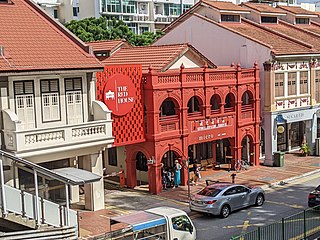
Katong is a residential neighbourhood in the eastern portion of the Central Region of Singapore, within the Marine Parade planning area. Katong district stretches from Fort Road area to Joo Chiat area. It used to be located by the sea, before land reclamation towards the south to East Coast Park was created for housing and recreational purposes beginning in the 1960s to 1970s.
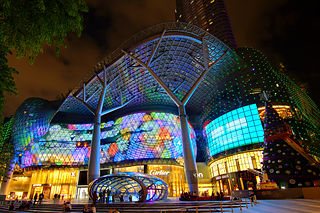
Orchard Road, often known colloquially as simply Orchard, is a major 2.5 km (1.6 mi)-long road in the Central Area of Singapore. A famous tourist attraction, it is an upscale shopping area, with numerous internationally renowned department stores, shopping malls, restaurants, and coffeehouses located in its vicinity.
Aljunied is a sub-urban area located in the central part of the city-state of Singapore. Named after Aljunied Road, it was formerly agricultural land which has since been heavily urbanised and presently comprises a variety of land uses. Today, Aljunied is a bustling neighbourhood with HDB flats with amenities like shops, schools, parks and recreational facilities, as well as quite a number of traditional Singaporean shophouses.

Tanjong Pagar is a historic district located within the Central Business District of Singapore, straddling the Outram Planning Area and the Downtown Core under the Urban Redevelopment Authority's urban planning zones. The district has a rich history and is known for its cultural and architectural landmarks, making it a popular tourist destination.
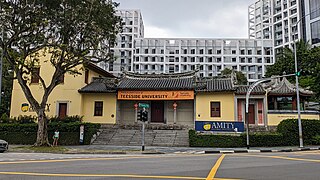
The House of Tan Yeok Nee is a mansion building located at the junction of Penang Road and Clemenceau Avenue in the Museum Planning Area in Singapore. After an extensive restoration completed in 2000, it was held by the University of Chicago Booth School of Business. As of 2019, the building serves as the Singapore campus for Amity Global Institute.

George Drumgoole Coleman, also known as George Drumgold Coleman, was an Irish civil architect who played an instrumental role in the design and construction of much of the civil infrastructure in early Singapore, after it was founded by Sir Stamford Raffles in 1819. Only a few of his buildings have survived in Singapore, most notably Armenian Church of Saint Gregory the Illuminator, Maxwell's House, and Caldwell House.

Hill Street is a major road in the Downtown Core of Singapore, starting from Eu Tong Sen Street and ending at Stamford Road, where the road becomes Victoria Street. The road starts after Coleman Bridge and at the junction of River Valley Road, North Boat Quay, Eu Tong Sen Street and New Bridge Road.

Tan Kim Seng, was a prominent Straits-born Chinese merchant and philanthropist in Singapore in the 19th century.
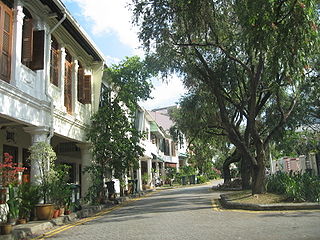
Emerald Hill is a neighbourhood and a conservation area located in the planning areas of Newton and Orchard in Singapore. Former home to many members of the city-state's wealthy Peranakan community, it is located near Orchard Road. Many of its homes feature Chinese Baroque architecture. Emerald Hill also the setting for some of the short stories by the late Singaporean author Goh Sin Tub. Many of the homes were designed by Mr R T Rajoo an architect/contractor of those days who died in 1929 at his home in Tank Road, Singapore.

New Bridge Road is a major one-way road located within the Central Area in Singapore.

Keong Saik Road is a one-way road located in Chinatown within the Outram Planning Area in Singapore. The road links New Bridge Road to Neil Road, and is intersected by Kreta Ayer Road.

Ann Siang Hill is a small hill, and the name of a one-way road located in Chinatown, Singapore. It was named after Chia Ann Siang, a wealthy businessman. The road links Club Street and Ann Siang Road (安祥路) to South Bridge Road.

Duxton Hill is a small hill, as well as the name of a road, located in Tanjong Pagar in the Downtown Core district of Singapore.
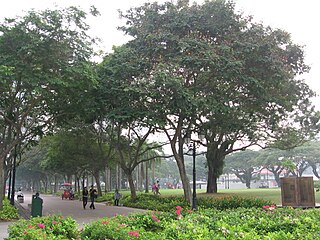
Esplanade Park is a park located at the Esplanade area within the Downtown Core district of Singapore.
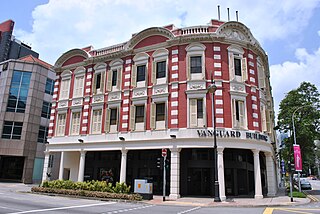
Stamford Road is a one-way road in Singapore within the planning areas of Downtown Core and Museum. The road continues after the traffic light junction of Nicoll Highway, Esplanade Drive and Raffles Avenue towards Orchard Road. It then ends at the junction of Fort Canning Road, Bencoolen Street and Orchard Road, which it continues to be Orchard Road. Stamford Road is home to several landmarks, including Swissôtel The Stamford and the National Museum of Singapore.

Ord Bridge is a pedestrian bridge in Singapore. It spans the Singapore River at Clarke Quay, located in the Singapore River Planning Area within the Central Area.

The Tan Kim Seng Fountain is a fountain in Singapore that was erected in 1882 in honor of notable philanthropist Tan Kim Seng for his donations for the Singapore's first reservoir and waterworks.
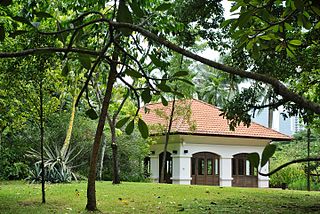
Raffles House is a single-storey building built on the Fort Canning Hill, Singapore. The original building was a wood and atap structure built in 1822 that was used as a place of residence by Sir Stamford Raffles. This building was later rebuilt as a neoclassical-styled Government House as the residence of subsequent colonial governors, but it was demolished in 1858 to make way for the construction Fort Canning. The present structure built on the same site is a brick and tile building constructed in 2003.
The Pavilion is a house located at 5 Oxley Rise, Oxley Hill, near Orchard Road in Singapore. The Pavilion served as Government House between 1859 and 1861, after Raffles House was demolished to make way for a fort.
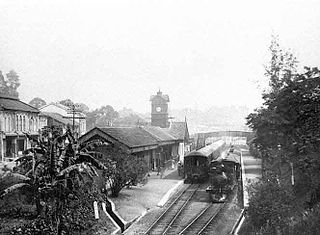
Tank Road railway station was a railway station which served as a terminus on the Singapore-Kranji Railway from 1903 to 1932.






















